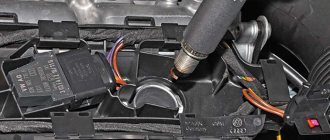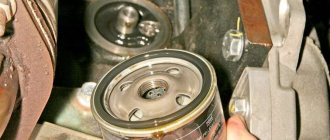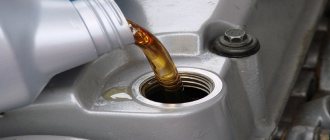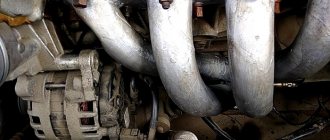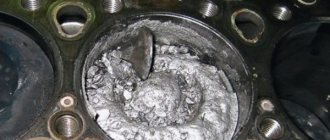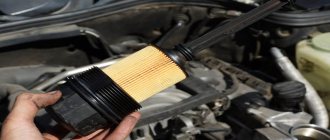The operation of an internal engine is impossible without lubricants. The oil must continuously wash all friction points and rotation points in the mechanisms.
To maintain the functionality of the lubrication system, the engine housing is made in the form of a bath in which a certain volume of technical fluid is constantly located. Using a pump and a complex oil pipeline system, it is supplied to all operating points.
During operation, the lubricant loses its characteristics, so it needs to be renewed periodically. This is a simple operation and can be done independently in a garage. Let's look at the procedure for changing the oil on the popular Volkswagen Polo sedan.
2276-4-8-03
Apply a thin layer of engine oil to the O-ring of the new filter.
We wrap the oil filter by hand and tighten it with a puller to a torque of 20 Nm.
Remove the oil filler cap. From the bottom of the car, clean the oil pan around the drain plug. We place a wide container for draining used oil, with a volume of at least 4 liters, under the drain plug.
What oil is used for Volkswagen Polo
The German automobile concern has a huge number of different engines. The same power plants are used on different models, the Volkswagen Polo sedan is no exception. There is an extended list of motor oil specifications that apply to Volkswagen AG vehicles.
| VW 500.00 | VW 501.01 | VW 502.00 | VW 503.00 | VW 503.01 | VW 504.00 | VW 505.00 | VW 505.01 | VW 506.00 | VW 506.01 | VW 507.00 | |
| Soot deposition | + | + | + | + | + | ++ | + | ++ | + | + | ++ |
| Wear | ++ | ++ | + | +++ | ++ | +++ | + | ++ | +++ | +++ | +++ |
| Sludge deposits | + | + | ++ | ++ | ++ | +++ | ++ | ++ | ++ | ++ | +++ |
| Piston deposits | + | + | ++ | +++ | +++ | +++ | + | ++ | +++ | +++ | +++ |
| Oxidative stability | + | + | +++ | +++ | +++ | +++ | — | ++ | ++ | ++ | +++ |
| Fuel economy | — | — | — | ++ | ++ | ++ | — | — | ++ | ++ | ++ |
| Compatible with aftertreatment systems | — | — | — | — | — | ++ | — | — | — | — | ++ |
| Typical viscosity | Any | Any | 0w 30/40 5w 30/40 10w 30/40 | 0w 30 | 0w 30/40 5w 30/40 | 5w 30 | Any | 5w 30/40 | 0w 30 | 0w 30 | 5w 30 |
In this case, the compliance of the tolerance for a particular motor is determined by the instructions for routine maintenance. For Polo sedan this is VW 502 00. According to the manufacturer’s descriptions, the lubricant is suitable for gasoline engines with a fuel injection system.
The tolerance allows lubricant to be poured into power plants with increased boost, and, accordingly, liter capacity. The European certification for this approval is ACEA A3.
This basic composition is intended for cars that have a standard (in other words, shortened) replacement interval specified in the service book.
In addition, the automaker has certified the VW 504 00 approval, the so-called “Longlife”. Changing such oil in the Polo sedan is done half as often. Of course, provided that the interval is provided for in the service book.
Information
The same engines are installed on other models of the concern: for example, AUDI, Skoda, Seat. Accordingly, Volkswagen approvals also apply to them.
So what kind of oil should you put in the engine? The manufacturer recommends (without directive instructions, otherwise antitrust laws will be violated) the so-called VW branded oil.
While you are being discussed at the dealer service (and you will have to do this, at least during the warranty period), rest assured that this particular consumable will be filled in for you. Then you can choose the brand yourself.
2276-4-8-04
Use a 18mm spanner to loosen the drain plug.
We unscrew the plug by hand and drain the oil.
Attention! Be careful - the oil is hot.
Drain the oil for at least 10 minutes. The drain plug cannot be reused, so we replace it with a new one. We wrap the plug and tighten it to a torque of 40 Nm. We remove oil leaks from the engine oil pan. Pour 3.6 liters of engine oil into the engine through the oil filler neck. Close the oil filler cap.
We start the engine for 1–2 minutes. We make sure that the indicator of insufficient (emergency) oil pressure in the engine has gone off in the instrument cluster, and also that there are no oil leaks from under the drain plug and filter.
We stop the engine. After a few minutes (so that the oil has time to drain into the oil pan), we check the oil level and bring it to normal.
[How to reduce maintenance costs for Volkswagen Polo sedan] [Maintenance of Volkswagen Polo sedan for 15 thousand km] [Maintenance of Volkswagen Polo sedan for 30 thousand km] [Tools required for maintenance of Volkswagen Polo sedan] [ Carrying out maintenance yourself - general recommendations] [Safety rules for carrying out car maintenance yourself]
Changing the engine oil and oil filter Volkswagen Polo sedan
Leaks and problems
The longer the mileage of the Volkswagen Polo Sedan, the more problems appear, as in principle in any car. Most often this is due to natural wear and tear of the engine, causing oil to burn. Although the manufacturer allows for a small consumption.
In general, speaking about the power of this model, it is worth noting that the engines are 105 hp. are not so susceptible to it. But at 1.6 MPI 110 hp. the problem is acute. The manufacturer himself admits this and writes about it in the instructions that consumption can be 1 l/2000 kilometers.
If the car is under warranty and the consumption is 0.5 l/1000 kilometers, then you can go to the dealer. This is a warranty case, but in practice such costs are exceptions. Typically, oil consumption does not exceed 1 l/10,000 kilometers.
Owners note the engine's sensitivity to bad oil. Therefore, it is advised to purchase it from official suppliers to avoid buying a counterfeit. It is also worth reducing the replacement interval and focusing on engine hours; the optimal interval is considered to be 250-300 engine hours.
All this is general information, which may manifest itself differently on each specific vehicle, since everyone’s operating modes are different. The same applies to places of leaks or oil leaks, which cannot be diagnosed from a distance.
In mechanical box
The rating of manual transmission fluids is as follows:
- Motul Motylgear 75W-90; Lukoil TM-5 75W-90; MOBIL Mobilube GX 80W-90; ELF Tranself NFJ 75W-80; Liqui Moly Vollsynthetisches Getriebeoil (GL-5) 75W-90.
Each option needs to be considered in more detail.
Motul Motylgear 75W-90 is a semi-synthetic product that has a number of advantages:
- lowest possible pour point; easier gear shifting; reduction of friction force; extending the service life of all components; reduced noise level.
The average cost of packaging is close to 1000 rubles.
Lukoil TM-5 75W-90 is a modern semi-synthetic development with a long list of advantages:
- high degree of oxidation resistance; corrosion protection; preservation of properties throughout the entire service life; cold start relief; fuel economy; resistance to low temperatures.
A liter bottle costs about 300 rubles.
MOBIL Mobilube GX 80W-90 is a mineral product with a large number of additives. The advantages of the liquid are obvious even with a quick study of the characteristics:
- effective additives; withstand high loads; high degree of protection of parts; temperature stability; good lubricating characteristics and more.
A twenty-liter package costs a little more than 5,000 rubles.
ELF Tranself NFJ 75W-80 is a product adapted for the Renault brand. Its advantages include:
- compliance with international standards; easier gear shifting; high turnover; additive effectiveness; corrosion resistance.
On average, a liter bottle sells for 500 rubles.
Liqui Moly Vollsynthetisches Getriebeoil (GL-5) 75W-90 - suitable even for the harshest weather conditions. The advantages of the product include:
- a wide range of additives; protection against corrosion and wear; high performance characteristics; optimal lubricating properties; compliance with international standards.
A liter of lubricant costs a little more than 1000 rubles.
Correct operation of the vehicle and timely maintenance are the key to a long service life and exclusion of expensive repairs from the list of expenses. Therefore, technicians recommend checking the lubricants in the transmission box yourself or seeking help from professionals.
When to change engine oil
The manufacturer recommends changing the engine oil at least once a year or 15,000 km , whichever occurs sooner.
After a mileage of 100 thousand km, the oil change period is reduced by 20% every 50,000 km.
From the factory, the engine is filled with original high-quality all-season motor oil Special Plus SAE 5W40. Therefore, during the first change, the oil poured must comply with the specifications specified in the registration certificate of your car.
Articles
| Name | Articles |
| Volkswagen Polo until 2015 | |
| Oil filter | 03C115561H |
| Motor oil | VAG G052167M4 |
| Oil drain bolt | N90813202 |
| Volkswagen Polo after 2015 (restyling) | |
| Filter | 04E115561H |
| Oil | VAG G052167M4 |
| Threaded plug | N90288901 |
| Drain plug gasket | N0138157 |
Preparatory work
The preparatory process includes the purchase of all consumables. Below are all the consumables needed for the job.
To receive the waste, prepare an empty 5-liter container (canister). Tools you will need:
- Key to remove the filter.
- Socket wrench No. 18.
- Bat "T-25".
- Head No. 13.
- And a ratchet for removing the crankcase protection.
You should also stock up on enough rags and prepare a funnel.
Flushing the lubrication system
Flushing the engine on a Volkswagen Polo Sedan should be carried out only in exceptional cases, which include:
- Purchasing a used car when you cannot know about the quality, as well as the regularity of lubricant replacements.
- During operation, the service replacement interval was repeatedly exceeded.
- Engine operation with constant frequent overheating, which contributes to coking and other deposits.
- In cases of switching to another type, for example from synthetics to semi-synthetics.
There are several types of flushes for the Polo Sedan engine:
- Five- or seven-minute, capable of cleaning even the most difficult deposits. They must be used very carefully and strictly follow the instructions printed on the packaging. It is recommended to use them only when absolutely necessary. Since there is a high probability of causing premature wear of the sealing seals. And also clog the oil channels with particles of washed away carbon deposits.
- Special compounds that are added to the oil several hundred kilometers before the expected change. They are more gentle, but there is also a possibility of clogging of the oil channels.
- Flushing oil is the most gentle method of cleaning the engine from the inside. This composition is poured after draining the waste, the engine runs for 15-20 minutes, after which the liquid with deposits is drained. The absence of aggressive additives in the wash composition gently cleans the engine, but is not able to remove heavy contaminants.
- Regular oil that you are going to use when changing. This method is not so popular due to its high price.
Before washing the Polo Sedan, you should weigh all the pros and cons. And also understand that it will not be possible to completely drain the liquid. Some of it will remain in the channels, which will then mix with the new oil.
Engine vw polo sedan 1.6 16v (gasoline) characteristics, fuel consumption, dynamics
- Working volume – 1598 cm3
- Number of cylinders – 4
- Number of valves – 16
- Cylinder diameter – 76.5 mm
- Piston stroke – 86.9 mm
- Power hp/kW – 105/77 at 5600 rpm
- Torque – 153 Nm at 3800 rpm
- Compression ratio – 10.5
- Type timing/timing drive – DOHC/chain
- Fuel brand – gasoline AI 95
- Ecological class – Euro-4
- Maximum speed – 190 km/h
- Acceleration to 100 km/h – 10.5 seconds
- Fuel consumption in the city – 8.7 liters
- Fuel consumption in the combined cycle – 6.4 liters
- Fuel consumption on the highway - 5.1 liters
Above are the dynamic characteristics and fuel consumption of a Polo sedan with a manual transmission; with an automatic transmission these figures are worse. So, acceleration to hundreds with automatic transmission takes 12.1 seconds, and fuel consumption increases by half a liter of gasoline.
A simpler engine in the VW Polo sedan 1.6 without a variable valve timing system on the intake shaft did not appear immediately, but after the manufacturer had to reduce the price of the car in the fight for customers.
A simplified version of the Polo sedan engine made the car a little cheaper, but the car's power also dropped. This engine has the factory index CFNB.
The chain mechanism remains, but the cylinder head is now in a simplified form without an actuator for stepless timing change.
The 85 horsepower Polo sedan engine is installed only in combination with a manual transmission. A new power unit appeared in the company’s lineup in Russia only in the middle of last year. This is why there is not much information about the detailed structure and design of the engine, but the main characteristics are known.
What third-party oil should I fill in the Volkswagen Polo?
To be fair, we note that there are no proprietary formulations produced at Volkswagen AG factories. The automaker orders consumables from partners.
Therefore, you can safely use any lubricants that meet the following conditions:
- approval VW 502 00 or VW 504 00;
- viscosity 5W30 or 5W40 (check the routine maintenance instructions).
Here is a partial list of 100% compatible oils with VW approval:
- Liqui Moly Leichtlauf High Tech 5W-40
- WOLF EXTENDTECH 5W40 HM
- Liqui Moly Special Tec LL 5W-30
- Motul Specific VW 5W-40
- Castrol MAGNATEC 5W-40
Information
The same goes for the oil filter. It is not necessary to look for a “branded” accessory with the VW logo. It is enough to select a consumable with approval.
Volkswagen polo sedan engine oil
The B-class Polo Sedan from Volkswagen was presented in 2021 during the Moscow Motor Show.
In fact, the model became an adaptation of the popular Polo hatchback for developing countries and Russian operating conditions. Externally, the European and Russian versions are similar, but technically they are completely different. Over the entire production period, the sedan received an update only once in 2022 and is still produced in this form. The restyling affected body colors, wheel design and redesign of the rear and front bumpers. In addition, the interior of the car was slightly redesigned.
In 2022, the manufacturer updated the line of engines, replacing them with more powerful ones.
The power units under the hood of the front-wheel drive Polo are quite unpretentious to the quality of gasoline and are today represented by power units with a volume of 1.6 liters and a power of 90 and 110 hp. (the first with a manual transmission, and the second with an automatic transmission or manual transmission) and 1.
4-liter turbo engine with 125 “horses” (robotic gearbox or 6-speed manual). Acceleration time to 100 km/h for the Polo Sedan is only 9 seconds, and gasoline consumption in the city/highway cycle is 5.7 liters per 100 km.
Data on oil consumption and what kind of oil to fill are indicated later in the article.
The adaptability of the Volkswagen Polo to our roads (the car body has special anti-corrosion protection and reinforced suspension) helped the model gain popularity in the domestic market.
The model quickly became on par with the segment leaders: Opel Corsa, Mitsubishi Colt, Ford Fiesta, Kia Rio. The spacious interior and trunk make the car an excellent and relatively inexpensive family option.
Since the start of sales, it has been available in a variety of trim levels depending on the level of equipment.

